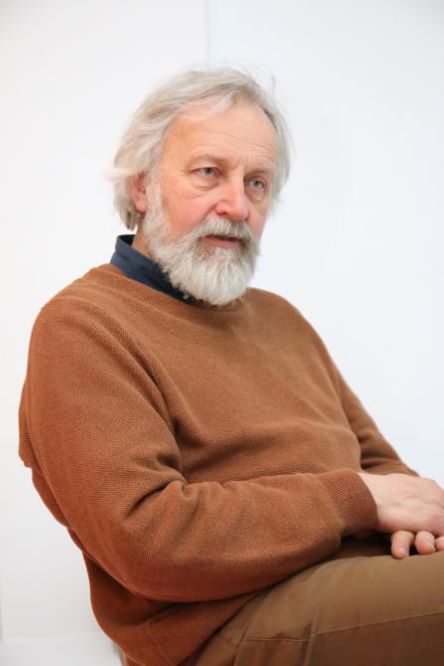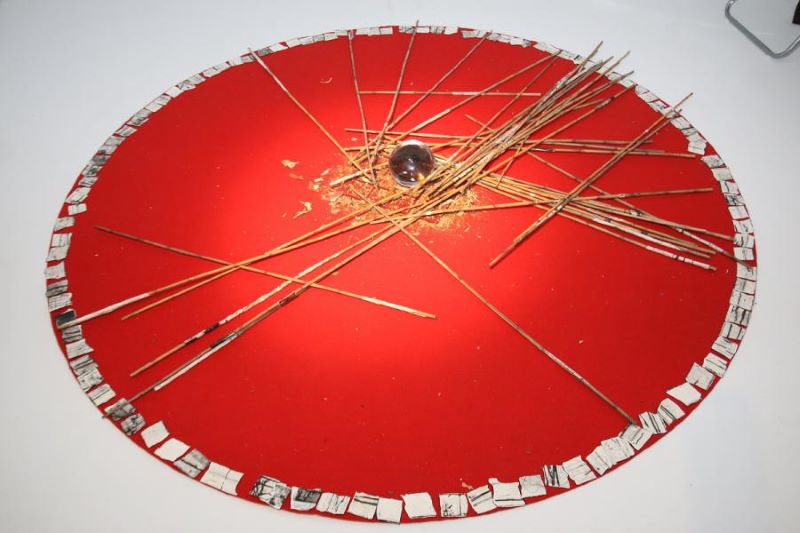| Maria Sztuka |
Visual works created using new means of artistic expression are increasingly often included in art gallery exhibitions. Virtual space, video art, installation, and artistic performances evoke many different feelings, which is very often what their creators are hoping for while searching for their own intermedium. We met with Prof. Krzysztof Kula from the Faculty of Arts and Educational Science of the University of Silesia in LAB 303. The curator at the Gallery of Intermedia Experiment of the Academy of Fine Arts and Design in Katowice (artist’s alma mater) at ul. Koszarowa is Dariusz Gajewski, PhD, DLitt, Associate Professor of the Academy of Fine Arts and Design in Katowice. It was on his initiative that ‘Wariacja – Koszarowa’, an installation by Krzysztof Kula, was available for viewing at the gallery in March.
The white, small area of LAB 303 is filled to the brim with a collection of items – artefacts and the video retrospective complementing the collection. If not for the recommendation to forget about the analysis, one might say that we are traversing the deconstructed engram space of the artist. And so, we direct our gaze onto the remains of printing plates enclosed in display cases, paint from a diploma polyptych, ‘common weekly newspaper roll’, brooch woven out of hair and cufflinks on a black drapery, crystal ball, leaves, bamboo twigs on a red carpet, socks with French and English national colours stretched over painting storage tubes, black briefcase with a mirror showing the past of Koszarowa street, Grzesio’s wooden stand, a bird toy, gorget Hommage a Gallery Engram with the photo of the artist, or the long-forgotten mirrors from Radovanovy radovánky.
The space seems to be filled to the brim with reflection, perhaps on the nature of existence, the passing of time and the pressing need to capture in the frame those legible and illegible, important and unimportant artefacts. A collage of thought, emotion, fading memories, a silhouette of someone’s shadow…
According to Krzysztof Kula, meetings, dialogue, shared inspirations, and exchange of thoughts and experiences are what matters in life.
‘In my case, those interpersonal relations, after some time, resulted in self-reflection and an increasing sense of creative freedom. Many of the people I encountered left a lasting imprint in my memory. Friends and artists, educators, and teachers, among others: Piotr Szmitke, Halina Antoszewska, Tomasz Struk, Grzegorz Banaszkiewicz, Mariusz Pałka, Adam Romaniuk, Marian Stępak – those people left undefinable imprints, which still continue to reverberate in the act of creation, because – as the artist emphasises – the creative process is infinite’.
‘First, I tackled the methods, practised rituals, checked various techniques, and the closer I was to the Master’s exam, the more the imperative to experiment intensified. The tubes from the installations are materials from my diploma. I understood that the passing of time does not matter and that the experiences and the impressions do not get any older. This is a sort of continuum, dematerialisation of the surface and the structure of drawings, paintings, and graphics. It’s eternal’, says the artist.
According to the professor, conversation (previously referred to as correction), understood as the cultivation of a relationship, which motivates and supports the artist in their pursuit of their own artistic vision and expression, plays an important role in the professional development of any artist.
On the one hand, the responsibility of a teacher is to educate the student on declarative and processual knowledge (both the creation of a piece through the artist’s own intermedium, as well as the topic of memory and time in performance art). On the other – to make them aware that visual thinking, i.e. processuality on the path towards the creation of the image – the visualisation of an image, plays a fundamental role in visual art. This kind of interpersonal relationship is the basis for the initiation and shaping of the artistic expression of the student.
Krzysztof Kula, born in Chorzów, is a graduate of the Jan Matejko Academy of Fine Arts in Kraków, Faculty of Graphic Arts in Katowice. He carried out his diploma project in 1993 at the Pracownia Grafiki Warsztatowej prof. Stanisława Kluski [Stanisław Kluska Graphic Arts Studio] and the Pracownia Rysunku i Malarstwa prof. Macieja Bieniasza [Maciej Bieniasz Drawing and Paining Studio]. In 1996-2011, he was the founder and manager of the Engram Gallery at the Krystyna Bochenek Katowice Culture Centre. Since 2009, he is implementing the artistic project entitled ‘Bieguny’ – a laboratory of ideas and exchange of experiences, as a reaction to the expanding territory of new forms of graphic imaging.
He has been teaching at a university level since 1997. In 2001 he successfully defended his doctoral thesis at the Academy of Fine Arts in Kraków, post-doc in 2006, and he received the title of a professor at the Academy of Fine Arts in Katowice in 2020. Currently, he heads the Performance Art and Drawing Studio at the Institute of Fine Arts at the Faculty of Arts and Educational Science in Cieszyn. His professional interests include performance art, video, graphic imaging, and drawing. He is the author of several dozens of individual exhibitions, including Poliptyk, Bieguny (with Adam Romaniuk and Grzegorz Banaszkiewicz), Wariacje Koszarawskie, Prewentorium; performance, including Podniesienie, Pies na grafikę, In aqua scribire, Ignis; he has also taken part in many national and international group exhibitions and presentations.

Prof. Krzysztof Kula | Photo by Agnieszka Sikora
‘It’s a description, conversion of emotions, thoughts, and values, filtration of artistic creation based on the life experiences of the artist’, says Prof. K. Kula. ‘A painting can sometimes carry a meaning based on life experiences. However, if an artist has nothing to say at a given moment – becoming silent and waiting for inspiration is worth considering. Therefore, we should sometimes consider silence, as attempting to recreate reality is not very important and maybe even downright impossible. The interpretation is important, and usually it is the context and some kind of an abstract, event though dressed up in something that might seem ordinary, that necessitates reinterpretation by both the artist and the recipient’, concludes the artist.
He started searching for his own, original artistic language, his own way to articulate art, already during his studies, by converting the experience of ‘here and now’ connected to the hands-on learning of the painting and graphics language, which remains its inarguable basis and without which the artist cannot express his thoughts and feelings.
‘Along with the development of skills came an increasingly clearer understanding of graphic imaging through painting. Unconsciously, I was an interdisciplinary artist, even though back in those days it was not as common as it is today. On the path of self-education, I searched for originality, for my own articulation of sorts. For me, the start and end point in experiencing art is the search for the idea, and during the creation of the piece – discovering the intermedium anew. Artistic practice understood this way seems to provide sufficient opportunity for openness, courage, and an uncompromising approach to art. I find myself existing in between performance, graphic imaging, and drawing. Skills and techniques understood as an artist’s language are only an instrument that still requires emotions, experiences, ability, and knowledge. Thinking about colour, processuality, and post factum documentation of performative activities, as well as in situ installations in nature, I often experience astonishment…!? It is an inherent component of the creative process’, points out the professor.
‘Material traces of memory referring to acquired experiences that bear witness to some sensation, viewed from a certain temporal perspective, are astonishing and the path to their occurrence is intriguing. It’s enigmatic that the re-discovered items, and their re-emergence in our imagination, constitute proof that they have ceased to be ordinary. By providing a new interpretation of facts, they revitalise emotions, reflect the atmosphere, and de-logicise the reality of the installation itself. The question of why they were set up this way might be asked not only by the recipients, but I too ask myself the same question each and every time. I am the first recipient of the things I create and communicate. Sometimes, the things we see here invite reflection. I await reactions, but simultaneously don’t expect anything, I am not ready for them, perhaps they can serve as proof that the piece of art is alive’, admits the artist.
The groundbreaking pieces by Prof. K. Kula were created in the comfort of his workshop in Koszarawa Bystra where the artist takes shelter against the civilisational noise. Certain breakthroughs in how he experiences art and life took place – says the artist – thanks to nature and his contact with it.
***
In the text accompanying the exhibition Wariacje – Koszarowa, Bronka Nowicka, an outstanding poet and visual artist writes the following: ‘Kula’s works, even though full of matter, are entirely oneiric. Kula produces dreams’. In the works, other recipients see a bunch of debris, traces of long-forgotten memories, which are still searching for their own place and there are also those that venture into the mist brimming with difficult, often forcibly released memories of painful experiences. However, as Salvador Dali once said, a true artist is not one who is inspired, but one who inspires others.
The article entitled ‘To leave the lenses and the analyses behind’ was published in the May issue of the Gazeta Uniwersytecka UŚ (USil Magazine) no. 18 (318).

Element of the exhibition ‘Wariacje – Koszarowa’ | Photo by Agnieszka Sikora





